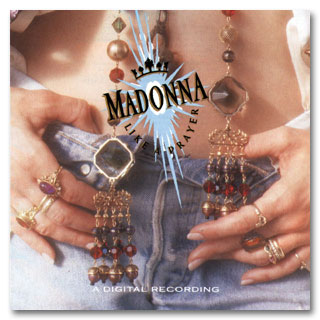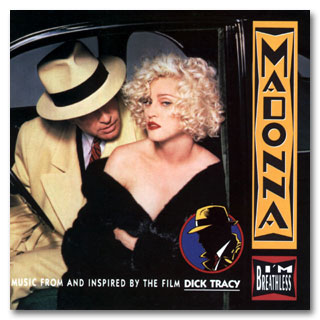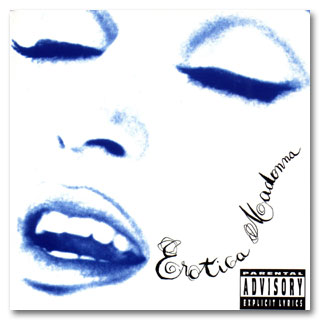| |
| |
It is said that artists are most
prolific when they are unhappy in love.
Thankfully, Madonna bucks that trend in her relationship with
Guy Ritchie, over six years that has yielded the Music
and American Life albums, the Drowned
World and Reinvention tours, a series
of children’s books, and, sure, Swept Away. Even though
we are approaching what may be her longest stretch without
a true single, there is no reason to doubt that Madonna, forever
fecund, is planning something fresh and exciting, in the worlds
of music, literature, and/or cinema. |
|
| |
As those
of us with former romances can attest, it’s not always
easy to forget the loved ones of the past, for better or
for worse. The lovelorn have always grappled with the ways
to forget a significant other and have come up with a variety
of questionable solutions.
These temporary fixes range from the drastic to the slight,
relocating away from an ex to erratically cutting the paramour’s
head out of old photographs.
But these exes are a part of who we are and ultimately inform
decisions and behavior at least subconsciously culled from
the relationship and applied henceforth.
Madonna has left many suitors, both of the serious and “fling”
varieties, in her wake.
She was the rebound queen, marching forward despite some
big ups and downs in her love life.
She never buried her head in the sand and quit producing
because of heartache or tumultuous goings-on in her private
life. No, she created art.
When Madonna looks back at her previous work, she is probably
reminded of the circumstances surrounding its creation.
No small part of those circumstances, I’m sure, was
the memory of stormy affairs and dubious pairings in which
she found herself.
Just like people who aren’t living legends - that
is to say, people like me and you - look through photo albums
featuring exes and are instantly transported back to a long-ago
coupling, Madonna has the same feelings, writ large. Instead
of a photo album, however, she has music albums. And actual
“eras.” (How cool would that be if you had eras
to define your life instead of lameass boyfriends and girlfriends?)
A young, scrappy Madonna found herself in the company of
similarly hungry bedmates in the time leading up to her
first album, Madonna.
She can’t look back at that time of discovery, eagerness,
and desperation and not think of Dan Gilroy, who essentially
got her into the music scene with the The Breakfast Club
(the band, not the movie), when the firebrand was reaching
the end of her rope with dancing; Steve Bray, her Detroit
area buddy whom she recruited to New York for accompaniment,
both musical and non-; and Jellybean Benitez and Mark Kamins,
crafty East Village denizens who had their fingers on the
collective pulse of the club scene, the very culture that
would spawn an untested single-monikered singer with a dancefloor-friendly
voice originally slickly marketed as African-American.
|
|
| |
She sang with an urgency
that has since understandably mellowed with time. We all know
the myths that have Madonna “pulling an Eva Peron,”
bedding men to get to places of power.
In the early years especially, world domination and all that
goes with it was on her mind, and if her boyfriends happened
to get in the way, well, Goodnight and Thank You. |
|
   |
The two sides of Brat Packer Sean Penn are personified in
the two albums that bookended Madonna’s turbulent
relationship with the actor: the charming (manic) True
Blue and the introspective (depressive) Like
a Prayer.
As the distaff half of the so-called “Poison Penns,”
Madonna threw herself into movies, theater, and touring,
as well. By the end of that explosive coupling, tempers
flared to extremes, abuse was alleged, Madonna found herself
defending her New York friends to Penn’s Hollywood
cronies, and more than one paparazzo found himself hospitalized.
The divorce on her resume is outshined
by nuggets like Love Song and Keep
It Together, tracks from what many critics argue
to be her best album.
But just as memories of your ex-boyfriend are evoked as
you whiff a familiar cologne on the subway, Madonna might
look at the cover of Like a Prayer and
be transported to a rocky, albeit artistically stimulating,
time in her life.
Lyrically, she was in her prime and surveyed several skeletons
lurking in the closet, from her motherless childhood to
the aforementioned split.
Madonna’s obsession with Hollywood
glamour of her Vogue period, immortalized
in Dick Tracy, ImmaculateCollection,
and, to a certain extent, Blond Ambition
led her to Warren Beatty, counterbalanced to the public
wackiness she demonstrated with iconoclastic comedienne
Sandra Bernhard.
Beatty, the handsomely aging sex symbol and legendary ladykiller,
was no stranger to the boudoir, and the couple did not do
much for Madge but boost her profile in the glitterati ranks
and provide one of the most famous utterances about Madonna
and her lust for fame: during Truth or Dare: In
Bed With Madonna, the documentary focusing on this
time in her life, when Madonna was asked by a doctor if
she wanted to tell him anything off the record, Beatty casually
and exasperatingly interjected, “Why say anything
if it’s not on camera?” The exchange spoke volumes
about the couple and that particular time of her life.
Erotica was an era that
most likely brings up some rough memories for Madonna.
She regularly took a beating in the press and at one point
was supposedly juggling Tony Ward, Vanilla Ice, and her
bodyguard Jim Albright. (Some would throw Rosie O’Donnell
into the mix, too.) Each relationship posed a challenge
for Madonna and yielded dark times, both privately and publicly.
Ward had a crippling addiction problem, Vanilla Ice was
a novelty rapper momentarily caught up in the American zeitgeist,
and Albright may not have been the rock Madonna so desperately
needed.
It’s no surprise that the Sex book
was released during this period. Though a monster hit, Madonna
has since said the book, the backlash, and the maelstrom
of her private life were vastly troubling.
The more R&B-flavored stylings of Bedtime
Stories echoed Madonna’s foray into the urban
landscape of basketball players (Dennis Rodman and Charles
Barkley, anyone?), Harlem video shoots, and using blue language
on late-night talk shows.
It was not until Ray of Light that this
transition period had a defining relationship with which
to point as a signpost to where Madonna was romantically.
His name is Carlos Leon. He remains an
important part of Madonna’s life as the physical trainer,
who took one of the most fateful jogs of his life the day
the two met in Central Park, is also the father of Lourdes,
one of the major inspirations for Ray of Light.
|
|
| |
No
small part of Madonna’s new sense of stability and
grace emanates from Carlos. In Lourdes, he provided Madonna
with a conduit for unconditional love and everything Madonna
said she sought from her absent mother.
While the dynamics of Madonna and Carlos’ relationship
has mostly been kept under wraps, seeing as the Grammy-winning
album stands up as one of Madonna’s finest works,
it is easy to comprehend how this translates to a happier
artist.
|
|
| |
And let me throw a bone to Andy Bird, the ne’er-do-well
rumored to be the inspiration for Beautiful Stranger.
Thanks, Andy, for riling up Madge enough into concocting
such a fun ditty. Extra thanks for then relinquishing her
to what has been her most creative and inspiring relationship
thus far!
You’re the devil in disguise. Next!
|
|
|
|
|


